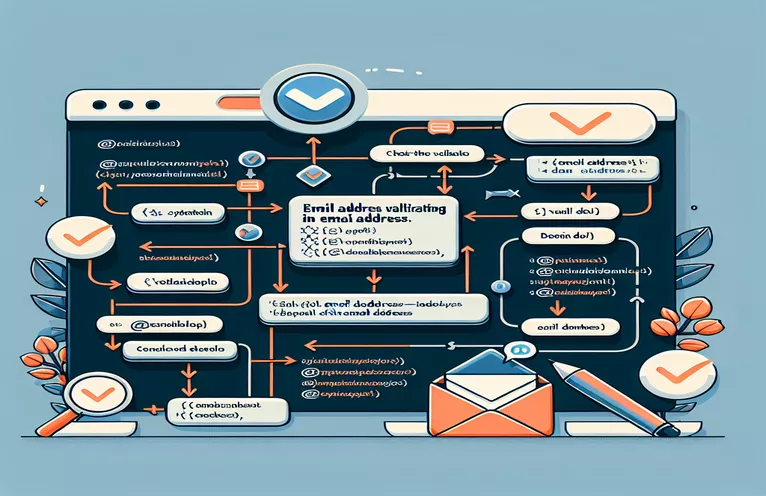The fundamentals of email validation with PHP
Creating dependable and secure web forms requires first validating email addresses. PHP validation goes beyond simply determining whether the character string contains a @symbol. Instead, it's a process that verifies the provided address satisfies requirements and is capable of receiving emails. In order to prevent input errors, lower the possibility of spam, and ensure efficient user communication, this verification is crucial.
The robust built-in functions that PHP provides for email address validation make the process both easy and thorough. By using these tools, developers may concentrate on other areas of their programs and build complicated tests without having to start from scratch. We'll examine a PHP email validation technique that strikes the ideal mix between ease of use and effectiveness, making it appropriate for the majority of online projects.
| Function | Description |
|---|---|
| filter_var | Utilizes a particular filter to validate and/or clean a variable. |
| FILTER_VALIDATE_EMAIL | Filter for email address validation. |
PHP Email Validation: Techniques and Recommended Practices
There is more to email address validation in web applications than just format verification. It is essential for protecting forms, eliminating spam, and enhancing user experience. PHP provides a reliable solution for this task with its filter_var function and filter FILTER_VALIDATE_EMAIL. This method uses the internet standards RFC 822 and RFC 5322 to analyze the supplied character string and decide if it matches the structure of a valid email address. By verifying that the email address satisfies specific technical requirements and includes necessary components like the "@" sign and a legitimate domain, this method also makes sure that the email is properly formatted and may even be functional.
Validating an email address's format does not, however, imply that it exists or is being used. For this reason, server-side validation is frequently combined with other methods like email confirmation (double opt-in). Using this method, an email verification is sent to the address provided, requesting the user to click a link to confirm their intention. This provides an additional level of validation, guaranteeing that the address is active and reachable by its owner in addition to being valid in terms of format. Developers can significantly increase the dependability of email correspondence and registrations in their applications by combining these strategies.
Email validation example
Server-side scripting language: PHP
<?php$email = "exemple@domaine.com";if (filter_var($email, FILTER_VALIDATE_EMAIL)) {echo "L'adresse email est valide.";} else {echo "L'adresse email n'est pas valide.";}?>
Detailed examination of PHP's email validation
Using filter_var with FILTER_VALIDATE_EMAIL is not the only way to validate emails in PHP. Despite this feature's strength, effective validation depends on knowing its limitations. For instance, it doesn't verify if the inbox is active or if the email address domain exists. In order to get over these restrictions, developers employ methods like SMTP checking to test the email address' responsiveness and DNS checks to verify the domain's existence. Nevertheless, putting these sophisticated strategies into practice might be more difficult and necessitate a deep comprehension of email communication protocols.
When implementing email validation, user experience is also a crucial factor to take into account. Overly stringent validation criteria may cause valid email addresses to be rejected because they are too old or restrictive. Therefore, it is recommended to utilize filter_var as a first validation step, and if an issue is reported, to provide the user with a chance to fix. This ensures that users are not unjustly prohibited from registering or participating because of unduly strict email validation, helping to maintain a balance between security and usability.
PHP Email Validation FAQ
- var_filter Does verifying every email address suffice?
- While it works well in most situations, using filter_var with FILTER_VALIDATE_EMAIL does not verify that the email address is active or exists at all. Additional checks, like DNS queries or SMTP checks, can be required for thorough validation.
- Can All Forms of Spam Be Prevented by Email Validation?
- Validation ensures that addresses are structured correctly, which helps prevent spam. However, it cannot stop all spam, particularly if addresses are auto-generated yet still valid.
- Can email addresses be verified without sending a verification email?
- Yes, you can use filter_var to check the domain's syntax and DNS, but without a verification email, you can't be sure the address is active.
- How should false positives in email validation be handled?
- Provide a mechanism for users to amend their input in the event that the address is first refused, and take extra precautions to account for unforeseen circumstances.
- What are the most effective methods for keeping verified email addresses on file?
- When storing addresses, care should be taken to protect personal data and use encryption when appropriate.
Keystones of Email Validation
In PHP, email address validation is a crucial part of maintaining the security and effectiveness of web applications. Developers can greatly enhance the caliber of registrations and the dependability of communications by carefully utilizing filter_var and implementing best practices, including email confirmation. This method is a vital initial step in guaranteeing a clean and useable user database, even though it cannot confirm the existence of an email address without user involvement. In the end, PHP email validation strikes a compromise between user accessibility and the developer's obligation to safeguard and manage secure networks.


